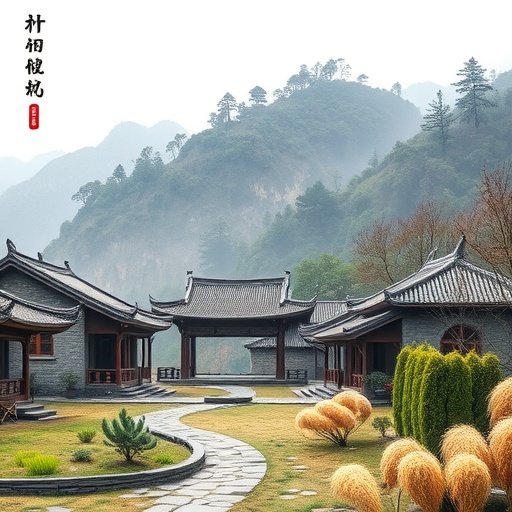In recent years, China’s ambitious rural revitalization campaign has garnered global attention for its multifaceted approach to economic development, environmental sustainability, and cultural preservation. One particularly intriguing dimension of this initiative is the strategic branding of cultural heritage as a mechanism for socio-economic transformation. The latest study by scholar M. Zhang delves into this complex interplay, using Qingtian County as a vivid case study to illustrate how cultural heritage branding intersects with rural revitalization in contemporary China.
Qingtian County, famed for its rich historical assets and intangible cultural heritage, emerges as a frontline exemplar of this initiative. The region’s traditional practices, unique craftsmanship, and folklore have historically been rooted in local identity but remained largely underleveraged as economic resources. Zhang’s research unpacks how deliberate branding efforts have repositioned these cultural assets as economic drivers, enabling sustainable rural development that honors tradition while fostering modernization.
Central to this branding process is the conscious curation and dissemination of cultural narratives aligning with both local pride and broader national rejuvenation goals. Zhang emphasizes that cultural heritage in Qingtian is not merely a passive relic of the past but an active, evolving symbol that can be packaged to resonate with diverse stakeholders — from local villagers to global tourists. This transformation hinges on meticulous storytelling, visual symbolism, and strategic media utilization, facilitated by digital platforms which amplify reach and engagement.
A critical technical aspect of this process involves balancing authenticity with market appeal. Zhang’s analysis reveals how Qingtian’s stakeholders navigate the tension between preserving traditional craftsmanship practices and adapting them for contemporary consumption. This requires collaborative frameworks involving artisans, community leaders, marketers, and policymakers to ensure that cultural commodification does not dilute the heritage’s intrinsic value but rather enhances its visibility and economic viability.
Moreover, the study highlights that branding cultural heritage within rural revitalization is not a linear, isolated endeavor but a dynamic system involving multiple layers of governance and civic participation. Local government policies play an instrumental role in providing regulatory support, funding, and infrastructural development, which are vital to sustaining cultural industries. Simultaneously, community engagement ensures that the branding process remains grounded in the lived experiences and aspirations of Qingtian’s residents, thereby strengthening social cohesion.
An innovative dimension discussed is the integration of technology into heritage branding. Zhang points out that digital storytelling, virtual reality exhibitions, and e-commerce platforms have revolutionized how cultural products are marketed and experienced. In Qingtian, virtual replicas of intangible heritage elements have not only extended audience access but also created new revenue streams, exemplifying how technological tools can invigorate rural economies while preserving cultural integrity.
The study also debates the role of cultural festivals and events as catalytic branding agents within rural communities. In Qingtian, these periodic celebrations have been reimagined as both preservation mechanisms and commercial showcases, attracting a sizable influx of tourists and media attention. Such events effectively serve dual functions: they reinforce cultural identity among locals and position Qingtian on the national and international cultural map.
Zhang’s empirical research draws on extensive fieldwork involving interviews, participatory observation, and archival materials, providing a rich ethnographic foundation. This qualitative methodology allows for nuanced insights into the perceptions and motivations of diverse actors involved in the branding process, revealing the social and economic dynamics driving rural revitalization through cultural heritage.
Importantly, the article contextualizes these findings within the broader theoretical frameworks of cultural commodification, rural development, and identity politics. Zhang critiques simplistic narratives that either romanticize cultural heritage or reduce it to a mere economic resource, instead proposing a more integrative model that respects cultural complexity while acknowledging market realities.
The implications of this research extend beyond Qingtian, offering valuable lessons for other regions grappling with similar challenges and opportunities. Zhang’s work highlights the potential for culturally informed branding to serve as a lever for inclusive rural development, fostering economic diversification without sacrificing cultural distinctiveness.
The study also cautions against potential pitfalls in the branding process, such as over-commercialization and cultural homogenization. By fostering critical awareness and adaptive strategies, Qingtian’s example provides a blueprint for managing these risks while maximizing cultural and economic benefits.
In addition, the article underscores the importance of sustainability in cultural heritage branding. Zhang advocates for frameworks that prioritize long-term community empowerment, environmental stewardship, and intergenerational knowledge transfer as essential components of successful rural revitalization.
Another salient point concerns the political dimensions of cultural heritage branding in China’s rural policies. Zhang elucidates how cultural heritage functions as a soft power resource, contributing to national narratives of modernization, civilization, and unity. This top-down encouragement intertwines with bottom-up community initiatives, creating a dynamic interplay shaping the identity and development trajectory of places like Qingtian.
Furthermore, the research identifies emerging trends such as youth engagement and creative industry incubation within rural heritage branding. Younger generations in Qingtian are increasingly involved in innovating cultural expressions, digital content creation, and entrepreneurial ventures that connect local heritage with global cultural currents, exemplifying a vibrant fusion of tradition and innovation.
Finally, Zhang’s study invites reflection on the transformative potential of cultural heritage branding as a sustainable pathway for rural revitalization. By marrying deep-rooted cultural values with strategic market orientation and technological innovation, Qingtian County demonstrates a compelling model that can inspire policy-making, academic inquiry, and rural communities worldwide.
Subject of Research:
Article Title:
Article References: Zhang, M. Branding process of cultural heritage in the context of rural revitalization in China: a case study of Qingtian County. Int. j. anthropol. ethnol. 9, 4 (2025). https://doi.org/10.1186/s41257-025-00127-9
Image Credits: AI Generated
DOI: https://doi.org/10.1186/s41257-025-00127-9




